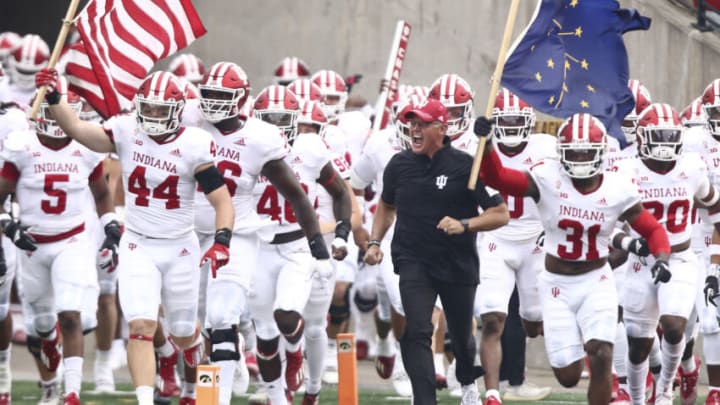What Indiana football must do to forget about 2021 and finish .500 or better in 2022 facing off against eight teams that went to a bowl game last season.
Is it possible to make the Hoosiers relevant again in the competitive Big Ten East? After a miracle-run in 2020 where IU went 6-2 (.750), claimed its highest AP ranking (#7) since being ranked #4 in 1967, but still fell short in the Outback Bowl against Ole Miss, 26-20, Indiana is looking to turn around and forget about a dreadful 2-10 (.167) 2021 season that started with a feeling of hope and excitement, then followed with disgrace and disappointment.
What better way to turn things around than gaining a new offensive coordinator, defensive coordinator, starting quarterback, lead running back, and just about everything else in between. We take a look at the five key factors for the Hoosiers to make a Bowl game this upcoming season.
#1 Head Man In-Charge
Without Tom Allen, where would the Hoosier Football program be? They would still be without a 7-win season since 2007, which Allen accomplished in 2019 (8 wins) and would still not be getting any national media focus due to being stuck at the bottom of the Big Ten East.
Allen has now taken back control the defensive play-calling duties and looks to bring his defense back to the top five turnover defense (#1 in interceptions) it was back in the shortened 2020 season that was led by now-Defensive Coordinator of South Alabama, Kane Wommack. With most FBS programs relying on strong defenses, the biggest factor in the Hoosiers’ success next season lies on the shoulders of Head Coach, Tom Allen.
#2 QB Competition Results
You can only pick one QB for the Hoosiers in 2022:
Player A (2021 Stats): 11 GP, 11 GS, 246/377 (65.3%), 2,548 PASS YDs, 6.8 YDs/ATT, 16 PASS TDs, 11 INT, -23 RUSH YDs, -0.7 YDs/ATT, 0 RUSH TDs, 130.2 QBR
Player B (2021 Stats): 7 GP, 4 GS, 35/82 (42.7%), 475 PASS YDs, 5.8 YDs/ATT, 2 PASS TDs, 2 INT, 135 RUSH YDs, 2.1 YDs/ATT, 2 RUSH TDs, 94.5 QBR
Player C (2021 Stats): 6 GP, 3 GS, 45/87 (51.7%), 423 PASS YDs, 4.9 YDs/ATT, 2 PASS TDs, 5 INT, 14 RUSH YDs, 0.9 YDs/ATT, 0 RUSH TDs, 88.7 QBR
The clear-cut choice seems to be Player A, who is Missouri transfer Connor Bazelak, but with the experience gained last season by Jack Tuttle (Player C) and Donaven McCulley (Player B), it does put things into question. If the Hoosiers decided to value a dual-threat guy under center, the choice could be McCulley, despite him seemingly making the move to the WR position. If they choose a guy like Bazelak, they will have a proven true QB with a high completion percentage that could add a ton of value to a potentially run-heavy offense.
#3 The Return of the Defense
According to Sports Reference, IU ranked 109th in opponent points allowed per game (33.3 PTS/GM), after ranking 20th in all of college football in opponent points allowed (20.3 PTS/GM) in 2020. Indiana’s defense in 2021 allowed 20+ points in 11 of 12 games (1-10, .091), which is the most such games allowed by IU’s defense since allowing 20+ points in 12 of 13 games (5-7, .417) in 2016.
Furthermore, the Hoosiers ranked #1 in all of college football in interceptions per game (2.1) in seven games in the COVID 2020 season, but only averaged 0.4 interceptions per game (#121 in FBS) in 12 games in 2021. The last team to average over 2.0 interceptions per game in a single season was Arkansas State in 2016 (2.0). It’s a guarantee that a change in defense will be a huge factor in a winning season.
#4 Run, Hoosiers! Run!
Did the Hoosiers lose all of their running backs from 2020 and 2021? Yes. Does Indiana have the “RBU” talent to produce the numbers they have in recent seasons? Probably not.
Despite that, Shaun Shivers (Auburn transfer) and Josh Henderson (UNC transfer), look to be in position to pair up as a good RB duo in this new-look Hoosier offense that will look to boost its scoring and run-offense drastically.
The Hoosiers, led by USC transfer Stephen Carr last season, were ranked 113th in rushing yards per game (116.3) and ranked 116th in rushing yards per attempt (3.3). Indiana was 3-1 (.750) in 2020 when averaging 3.0+ yards per attempt, then followed that up with going 2-5 (.286) when averaging 3.0+ yards per attempt in 2021. With the question mark that is the quarterback situation, Indiana cannot rely on a proficient passing game to save the offense like they seemed to try in previous seasons with the injury-riddled Michael Penix Jr.
#5 Memorial Field Advantage
The Hoosiers start the 2022 season with three home games against teams that were a combined 8-12 (.400) on the road last season, which is the perfect setup (hopefully) for another matchup on the road against preseason ranked #4 Cincinnati on September 24th.
In 2020, Indiana was 3-0 (1.000) at home averaging 33.6 points per game and only allowing 22.3 points per game, versus going 1-5 (.167) at home in 2021 averaging 19.8 points per game and allowing 33.2 points per game. If IU can protect home-field advantage and win at least four of their seven home games, making a bowl game is definitely within reach.
